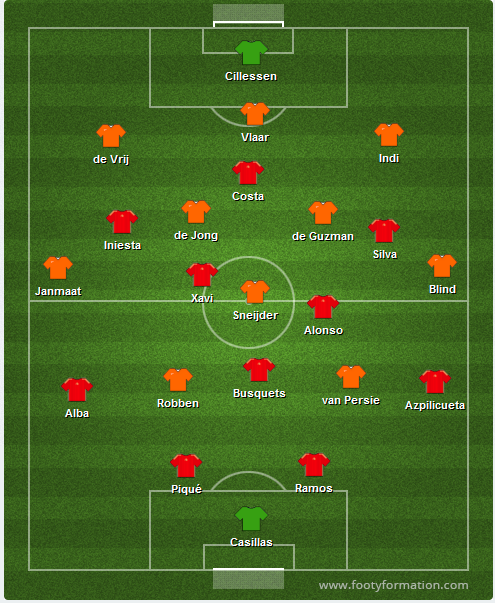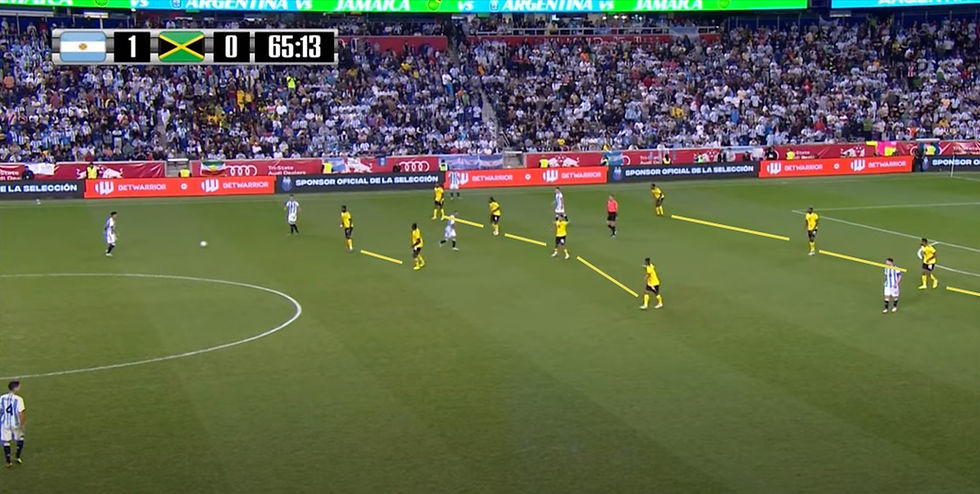World Cup Tactical Trends: 2014 Brazil
- All Angles Football -
- Jun 20, 2020
- 7 min read
This post is the second part of a three part series briefly exploring tactical trends that have been displayed in the past three FIFA World Cups. An earlier post, highlighted the trends in the 2010 World Cup which included:
The emergence of the 4-2-3-1 being a mainstream use formation
The importance of wingers, holding midfielders and the No. 10 in the 4-2-3-1
Spain’s tiki-taka possession based style of play
Prior to the 2014 World Cup, new tactics came to prominence and these were displayed at the tournament. One of the main tactics that was commonly used at the 2014 World Cup was the use of the back 3 which became popular partly in an effort to counter possession based football which was successfully used by Spain and Barcelona prior to and during the 2010 World Cup. In addition to the use of the back 3, other popular tactical trends from the 2014 World Cup included the redefined role of the modern goalkeeper and counter attacks including the importance of transitions. These will each be briefly explored with examples from the tournament.
The Redefined Modern Goalkeeper (Sweeper Keeper)
Before the 2014 World Cup, the standard expectation was that a goalkeeper would just be shot stopping and clearing any dangers from crosses and long passes into the penalty area. However, Germany’s Manuel Neuer redefined the role of the goalkeeper and this was showcased to the world during the 2014 World Cup - especially in the Round of 16 against Algeria. Manuel Neuer has always been this type of goalkeeper throughout his career at Schalke and Bayern Munich, but the success and popularity obtained by the Bayern Munich and Germany teams of this era saw this redefined role come to fame and gain praise. The origins of the sweeper keeper did not start with Manuel Neuer but can be traced back to the 1950s and 1960s with goalkeepers such as Lev Yashin of the USSR, Tommy Lawrence of Liverpool and Gyula Grosics of Hungary. However, in the modern day Manuel Neuer is without question the goalkeeper who has personified and defined this role, bringing it to fame. Claudio Bravo of Chile and Manchester City, Marc-Andre ter Stegen of Germany and Barcelona and Ederson of Manchester City and Brazil are also modern day examples of goalkeepers who play a similar role.
The modern day goalkeeper has to be technically skilled and comfortable with the ball at his feet. He plays not just as a goalkeeper but as an 11th outfield player being able to make short and long passes to build up plays and break lines going forward for his team. He has to be able to spot danger and be comfortable rushing out of his box to make tackles and interceptions which also allows the defenders ahead of him to be able to play a higher line, therefore reducing the distance the team has to cover to be in the opposition’s box. The sweeper keeper is basically a third or even fourth center back depending on his system, hence the term. As the last man, it is a dangerous role to play which requires critical and careful analysis of the situation ahead as any mistake can lead to a goal being conceded. However the benefits are great as there is one more player to help start plays and be involved with getting the ball forward as well as another player to sweep up any danger in attack by making tackles, interceptions and being quick to come out of the box to do so.
A clip below displays Neuer playing this role in the match against Algeria at the 2014 World Cup. The second clip, shows the dangers of this as Neuer made a mistake in the 2018 World Cup leading South Korea to score against Germany sending them home.
Three at the Back
At the end of the 2010 World Cup, possession based football was seen as the way to go and the way to win. Spain had dominated the international stage from 2008 to 2012 with tiki-taka and the major question was if this would continue in 2014. The answer was no. Many teams used both counter attacking football and/or a 3 in the back formation as a means to counter the now popular possession based style of play. The perfect example of this, although not the only at the 2014 World Cup, was the 5-1 destruction of Spain by the Netherlands. Louis Van Gaal lined up with 3 central defenders and two wing backs against Spain, the Dutch were happy to concede possession to the Spanish at 57% to 43% of possession. Chile, in the same group as the Netherlands and Spain, also used 3 in the back and defeated Spain 2-0.
The 3-5-2 was resurrected by Antonio Conte at Juventus with the strong central defensive trio of Barzagli, Bonucci and Chiellini which was the foundation of a very successful Juventus team for years. It was also the foundation of Italy’s Euro 2016 team which knocked out Spain in the Round of 16 although the Italians were less talented individually (Note that Spain has never beaten Italy in recent years when Italy lined up with 3 in the back). Conte also proceeded to use a 3-4-3 at Chelsea in his first year when winning the Premier League. 3 in the back systems are not outdated anymore but have proven to be a successful tactic to play with.
Three central defenders allows an extra body in defense and with a holding midfielder (or two depending on how a specific team is set up) provides stability. It gives the ability to clog the center of the park and create central overloads to make it difficult for possession based teams like Spain to break lines and penetrate the defense. With one or two holding midfielders, an extra center back and two wing backs that defend but are also positioned to quickly transition and expand the width of the play going forward, three in the back was a go to for many teams such as Costa Rica, Mexico, Chile and the Netherlands at the 2014 World Cup. As Michael Cox wrote for ESPN, “By the end of the group stage, three-man defenses had played eight matches against teams playing a back four, and remained unbeaten, with only two draws”, showing the potential successes of this system for many teams. The image below of just the line ups for Spain vs the Netherlands can show how the system was effective against Spain by just observing the positions of De Jong and De Guzman covering the lines between the 3 center backs while the wing backs covered space on the outside defensively, but also played a major role on the attack. This would have made it difficult for Spain to play through the Dutch.

As with any formation, three in the back is not a rigid system but can be played as a 3-4-1-2, 3-4-3, 3-5-2, 3-1-4-2 and many other variations with the roles of the midfielders and wing backs varying. For example, Costa Rica’s wing backs in the 2014 World Cup were much more defensive than those of the Netherlands. What was seen at the 2014 World Cup though was that this was one way to beat possession football and that it could be a successful formation after years of 4-4-2 and 4-2-3-1 as mainstream formations. Not only was it seen that 3 in the back systems can be successful and also counter possession football, but it was also seen that possession based football is nothing without purposeful and penetrative possession, hence Spain’s short lived display at the tournament. In the highlights of the two games below you can see the following:
The role of Daley Blind as a left wing back in the first two goals the Netherlands score
The role of Arjen Robben and his pace on the counter attack in the last goal for the Netherlands
How Costa Rica consistently create a block in and around the 18 yard box to prevent the Netherlands from passing through
How Costa Rica play on the counter attack, the one close chance they had was from a counter attack
Counter Attacks and the Importance of Transitions
In 21 of the 64 matches played at the 2014 World Cup, the team with less possession of the ball won. Most, if not all, of these victories were results of quick, efficient counter attacks. As mentioned, many teams used 3 in the back and/or counter attacks to defeat possession based football such as tiki-taka. Some teams based their whole tactic of counter attacking by creating a low compact defensive block and conceding possession to the opposition such as Costa Rica, while others did not set up to play like this but also used counter attacks dangerously and effectively when the opportunity appeared such as Germany (especially in the 7-1 against Brazil).
By forming a low compact defensive block, it would be difficult for the team with possession to pass through the lines and work the ball through the block. Once possession was won by the counter attacking team, they would usually push numbers forward and move the ball forward very quickly either through long balls, speedy players or a combination of both and this is perfectly seen in the highlights of the Netherlands vs Spain. It would be important to get the ball forward and transition from the defensive phase to the attacking phase of play very quickly as the opposition would usually commit many players forward into the attack and would therefore not have much cover defensively and be very open, which makes this a very effective style of play to counter possession based football.
3 in the back is not the only set of formations that allow counter attacking football to be played, in fact two defensive lines of four with a holding midfielder in between them is just as effective. With 3 in the back systems, the role of the wing backs who are defenders out of possession and attackers in possession, are very important. These wing backs are the players who are important on the transition and can play a major role in bringing the ball forward on a counter attack because of their pace and starting position. Three in the back systems were also likely popular for this counter attacking football during this World Cup because of the ability to block lines (shown above) and just the idea of having an extra body in defense.
The clips below demonstrate:
The role of quick players on the counter attack, specifically Robben drifting into space and also carrying the ball forward on the counter
How Germany used counter attacks to destroy Brazil even though their team was not set up to play only counter attacking football. This is seen specifically with the first two goals, note how quickly they transition from defense to attack. Also take note of the third goal which shows that possession has to be purposeful and efficient and not just impotent.
Overall, what can be seen is that football evolves on the field. In an effort to counter the possession based style of football that was seen as the successful tactic, many teams began to play counter attacking football and/or 3 in the back systems. Along with the redefined role of the goalkeeper, these were the main tactical highlights of the 2014 World Cup as a result of the benefits these tactics provide, especially in defeating the previously popularized possession based style.




Comments